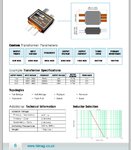shatruddha
Full Member level 2

Hello All
I was working on a project, where I needed to seal a plastic using impulse heating. While doing my calculations, I found that I need a power supply of atleast 1.5kW. So I thought of making a power supply of 2kW, so that if at later stage my power requirements are increased, I wont have to redo the work.
My concern is if I should go for a normal transformer or a switched mode power supply.
If I go with a normal transformer, my disadvantages will be heavy power supply as well as high cost of transformer.
All I can think of is, I do not need an accurately regulated voltage on my output. If I work out for SMPS, I'm confused if I need to use PFC (I read at few links that PFC is kind of redundent for power supplies greater then 1kW, dont know if thats the case though). Secondly will it reduce my cost, as SMPS converts DC signal to high frequency AC, reduce the voltage using a high frequency ferrite transformer and then again convert it to DC. So here is my another question- Do I need to convert this high frequency AC to DC, since my application is Impulse heat sealer, only current does matter to me, no matter if its AC or DC (I'm not sure with this part though).
So from my understanding, all I need is, convert high voltage AC to low voltage AC signal, and I can get desired power for my sealer.
So from my point of view, my design will be fairly simple : rectify the main AC signal (PFC or no PFC still a question)->I get a DC signal here, with ripples though; convert this to high frequency (say 50kHz)-> ferrite core transformer -> low voltage 50kHz (here I think I can feed this signal directly to my impulse heat electrode)
Any inputs in this will be highly appreciated.
Thanks and Regards
Shatruddha
I was working on a project, where I needed to seal a plastic using impulse heating. While doing my calculations, I found that I need a power supply of atleast 1.5kW. So I thought of making a power supply of 2kW, so that if at later stage my power requirements are increased, I wont have to redo the work.
My concern is if I should go for a normal transformer or a switched mode power supply.
If I go with a normal transformer, my disadvantages will be heavy power supply as well as high cost of transformer.
All I can think of is, I do not need an accurately regulated voltage on my output. If I work out for SMPS, I'm confused if I need to use PFC (I read at few links that PFC is kind of redundent for power supplies greater then 1kW, dont know if thats the case though). Secondly will it reduce my cost, as SMPS converts DC signal to high frequency AC, reduce the voltage using a high frequency ferrite transformer and then again convert it to DC. So here is my another question- Do I need to convert this high frequency AC to DC, since my application is Impulse heat sealer, only current does matter to me, no matter if its AC or DC (I'm not sure with this part though).
So from my understanding, all I need is, convert high voltage AC to low voltage AC signal, and I can get desired power for my sealer.
So from my point of view, my design will be fairly simple : rectify the main AC signal (PFC or no PFC still a question)->I get a DC signal here, with ripples though; convert this to high frequency (say 50kHz)-> ferrite core transformer -> low voltage 50kHz (here I think I can feed this signal directly to my impulse heat electrode)
Any inputs in this will be highly appreciated.
Thanks and Regards
Shatruddha




